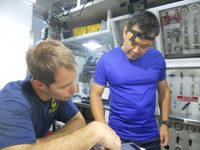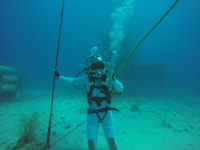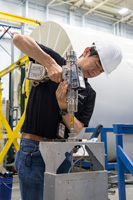JAXA Astronaut Activity Report, July, 2014
Last Updated: September 9, 2014
This is JAXA’s Japanese astronaut activity report for July, 2014.
As Commander, Astronaut Akihiko Hoshide participates in the 18th NASA Extreme Environment Mission Operations

Astronauts Hoshide and Pesquet discuss in the Aquarius (Credit: JAXA/NASA)

Astronaut Pesquet performing EVA (Credit: JAXA/NASA)
As part of training for an extended stay on the International Space Station, Astronaut Akihiko Hoshide, as Commander, participated in the 18th NASA Extreme Environment Mission Operations (NEEMO18); held off the coast of Tavernier, Florida, in the U.S.
The training is held in an underwater laboratory called "Aquarius" and aims to prepare participants for an ISS long-duration stay and future manned space exploration as well as improve the team’s behavioral ability by cohabitating with other participants for several days in an isolated environment.
For nine days from July 21-29, Hoshide was joined by NASA Astronauts Jeanette Epps and Mark Vande Hei, ESA Astronaut Thomas Pesquet and two technical support staff.
In the submarine outside the laboratory, Extravehicular Activities (EVA) on asteroids and Mars were simulated to verify sample-collection techniques and tool usability, and develop and verify operational procedures. To simulate a workplace far from Earth, a communication time delay with the ground controller was imposed.
In the laboratory, medical and scientific experiments and hardware verification were conducted anticipating ISS and manned space exploration beyond Earth orbit.
During the training period, Commander, Hoshide organized the team to ensure the success of the mission, while remaining mindful of the safety of the crew.
Astronaut Kimiya Yui continues training for his upcoming long-duration ISS mission
Astronaut Kimiya Yui, who was assigned as a crew member for the Expedition 44/45 mission to the International Space Station (ISS), underwent training for this long-duration mission at the NASA Johnson Space Center (JSC) until mid-July, and subsequently at the GCTC later in the month.

Yui simulating tool operation as part of the EVA training (Credit: JAXA/NASA/James Blair)
The JSC hosted various training programs. Training for the Space Station Remote Manipulator System (SSRMS) covered the capture of unmanned visiting vehicles and onboard training procedures to refresh SSRMS operational skills, etc. EVA training included size adjustment of the Extravehicular Mobility Unit (EMU) and EVA tool usage. Yui also trained to respond to ISS electrical power system failure, an emergency rescue assuming that one of the crewmates had suffered a cardiac arrest, and medical research themes conducted on the ISS.
In addition, based on the exercise procedure of the NASA’s SPRINT experiment, he actually exercised in the same manner as the onboard crews. The SPRINT experiment aims to develop an exercise program to minimize loss of muscle and bone. He also learned the procedure of the Body Measures experiment, which aims to understand changes in body shape and size among astronauts subject to microgravity for an extended period.
In Russia, Yui’s training was focused on improving manual operations techniques of the Soyuz Spacecraft. Using a simulator, he practiced approaching and docking operations to the ISS, as well as re-entry operation. Yui also experienced the hypergravity condition generated by a huge centrifuge accelerator, which he would experience as the Soyuz spacecraft re-entered the atmosphere.
Astronaut Takuya Onishi continues training for the ISS long-duration stay
Astronaut Takuya Onishi, a crew member for the ISS Expedition 48/49 mission, underwent training at the Gagarin Cosmonaut Training Center (GCTC) in early July, followed in the latter half of the month by training at the NASA Johnson Space Center (JSC).
In Russia, he trained using a life support system that creates the environment required for humans to live on board the Soyuz spacecraft. He was lectured and practiced using a simulator. Subsequently, Onishi took an exam to confirm the knowledge and techniques acquired and completed the training.
For training with the Soyuz Spacecraft, Onishi learned about the Interface Leak Check System of the docking ports with the ISS.
Regarding the ISS Russian segment, he familiarized himself with internal structures and hardware layout.
At the JSC, his training centered on EVA, covering standard working procedures, an overview of Orbital Replacement Units (ORU) maintenance, and EVA tool awareness, as well as hardware equipped in the Quest Joint Airlock, which is the ingress and egress path for U.S. EVA.
In addition, he was also trained in systems controlling the overall U.S. segment including Command and Data Handling (C&DH), Communication and Tracking (C&T) system, and Thermal Control System (TCS).



